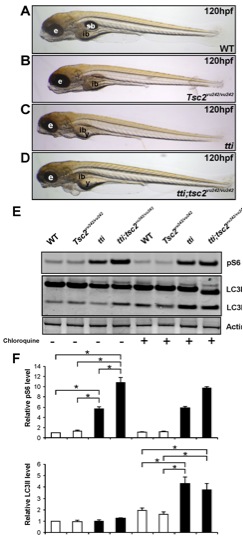Fig. 8
(A) Western blot analysis of Tp53 protein in whole cell lysates of WT (lane 1) and ttis450 (lane 2) larvae at 96 hpf reveals up-regulation of Tp53 expression in ttis450. Larvae treated with roscovotine (ROS; lane 3) to induce Tp53 protein expression or untreated larvae (lane 4) are positive and negative controls, respectively. The Actin signal provides a loading control. (B–E) Relative expression of ΔN113p53 (B), mdm2 (C), cyclinG1 (D) and p21 (E) mRNAs in WT, ttis450 (pwp2h-/-), tp53M214K/M214K (tp53-/-) and ttis450;tp53M214K/M214K (pwp2h-/-;tp53-/-) larvae at 96 hpf (n = 3) demonstrates that the expression of Tp53 target genes is increased in ttis450 compared to WT larvae (compare first 2 bars in all graphs). The Tp53 response is diminished on the tp53M214K/M214K background, as expected (compare 2nd and 4th bars). Data were normalised by reference to Elongation factor alpha (Elf-α) expression. (F) Western blot analysis of LC3 in whole cell lysates of tp53-mutant (tp53M214K/M214K) and ttis450;tp53M214K/M214K larvae at 96 hpf. The elevated autophagic flux in ttis450 larvae due to ribosomal stress is not diminished on a tp53-mutant background. (G) Graphical representation of the data shown in F and two additional experiments. Bars represent the mean +/- SD (n = 3), *p<0.05. (H) Transmission electron micrographs of IECs of ttis450;tp53M214K/M214K larvae at 120 hpf (right panel) reveal electron dense vesicles, resembling autolysosomes (white arrowhead), in comparable numbers to those found in ttis450 larvae with WT Tp53 expression (left panel).

